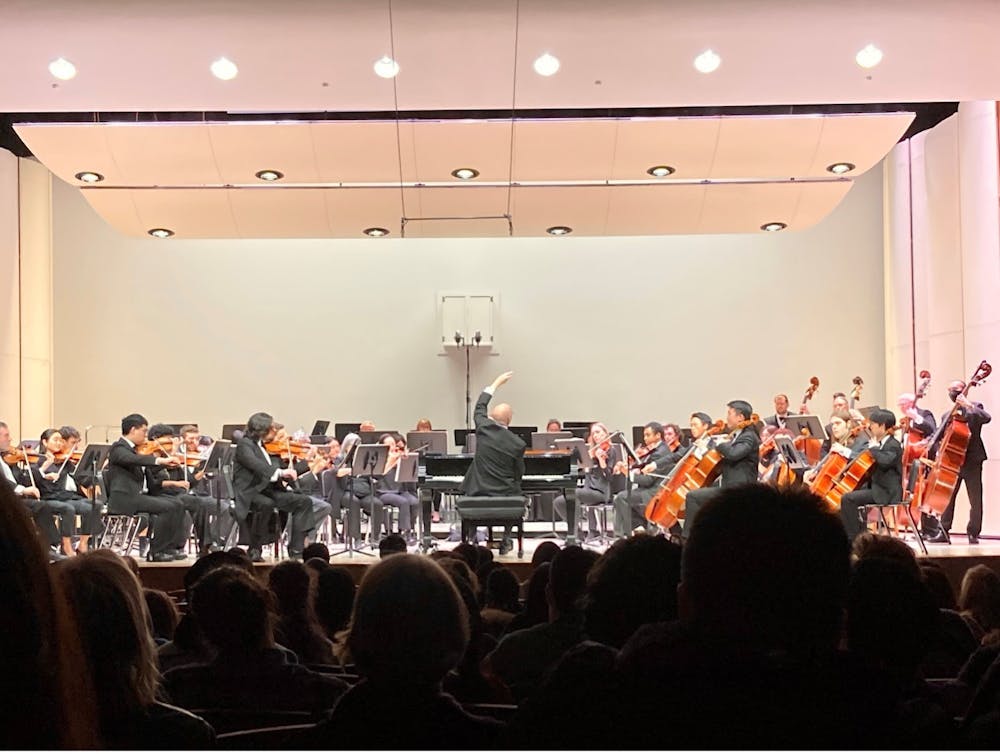On the evening of March 3, the Hopkins Symphony Orchestra (HSO) gave a concert titled “The Maestro,” celebrating the 30th anniversary of Music Director and Conductor Jed Gaylin. They played pieces by Mozart, Amanda Harberg and Manuel de Falla.
In an unusual departure from most HSO concerts, Gaylin was not only the conductor but also the soloist for this performance. The concert began with Mozart’s Piano Concerto No. 2, where Gaylin conducted from the piano bench where he performed as the soloist.
As the orchestra began to play, Gaylin conducted with his arms flourishing, raised high above his head. Ostensibly, this was so that the orchestra could see his movements despite him not being up on a podium. Yet I couldn’t help but feel as if these raised gestures were exaltation in movement, expressing joy in every beat. The concerto had a wonderfully bright, easy and playful sound which brought a celebratory mood into Shriver Hall that night.
The piano and orchestra would trade phrases in an almost conversational manner. It felt as if the conductor was finally allowed his own voice with which to speak alongside the orchestra. In an interesting way, the addition of this separate voice made the orchestra feel more like a single body, as there was a greater sense of the orchestra all intently listening to the piano and taking their cues directly from his phrasing. More than soloist and orchestra, this felt like two old friends having a conversation after a long separation.
Gaylin’s piano playing was truly a joy. Though not overly flashy, his solos were played with crystal clarity and sweetness, like listening to spun sugar in musical form. I felt like I could sit there and listen forever. When the concerto finished, many members of the audience stood up in a standing ovation. He was given a bouquet of flowers, of which he took out several stems and distributed them to members of the orchestra.
After the applause finally died down, Gaylin expressed his thanks and announced his encore piece would be Schumann’s Romance No. 2, because his “time at HSO has felt like a very short romance.” Many members of the orchestra put down their instruments and leaned back in their chairs to listen as he began to play.
The piece had a lovely and light sound to it. It was played in a leisurely manner, taking its time, yet the upward movement of its phrasing still gave it a sense of forward movement. It contained more moments of darkness than the Mozart piece, but these gave it a feeling of nostalgia and thoughtful memory. The ending to the piece was left unresolved. Yet instead of creating tension, it felt more like a gentle reminder that the story is unfinished, that there is still more work to be done and more music to be made together.
After the intermission, the piano was removed, and Gaylin conducted from the podium once more. The next piece was “On Rousseau” by Amanda Harberg, a contemporary composer. The piece is based on Henri Rousseau’s painting The Sleeping Gypsy. The piece was wonderfully fanciful and textured, having some jazzy elements as well. It had many moments of whimsical pizzicato from the whole orchestra that really created the sense of a lion tiptoeing around a lone sleeping woman as in the painting. There were also several more legato, soaring phrases that just looked incredibly fun to play.
The next three pieces were all composed by the Spanish composer Manuel de Falla. In his remarks after intermission, Gaylin said that his only complaint about de Falla was that he didn’t leave us enough music. He described the music as being rhythmically charged, sensual and sexy, which I definitely agreed with after hearing them firsthand.
The first two de Falla pieces that HSO played were his “Three-Cornered Hat,” Suite No. 1 and No. 2. These pieces came from a ballet written during the early 20th century about a magistrate pursuing a miller’s wife. The piece immediately kicked in with a high-energy percussion part. Then the rest of the orchestra came in with beautiful and nail-biting tension. Even without knowing the complexities of the story, I could still understand it from the orchestra’s vivid storytelling.
I loved hearing the raw, dramatic sound from the orchestra. The HSO is a huge ensemble, and these pieces were the places where they really showed the volume of sound they could create. At times they made me feel like I’d just been hit by a truck full of firecrackers in the best way possible. From Mozart to de Falla, the HSO more than proved their capability of playing a wide range of music.
The final piece of the night was the “Ritual Fire Dance” from El amor brujo, also by Manuel de Falla. This piece told the story of a woman dancing around a fire with the ghost of her dead husband before he eventually disappears. It’s an intense fast-paced piece, and I loved hearing the energy the orchestra brought to it. Even after a two-hour-long concert, they showed no sign of exhaustion and ended the concert in a brilliant crash of chords played in incredible synchrony.
Every piece picked for this concert was joyful, energetic and alive. It was a fantastic celebration of Jed Gaylin’s anniversary with the orchestra, and everybody looked like they were having fun with all of the pieces they played that night. I feel that Gaylin can be proud of the incredibly talented ensemble that he’s led, and I look forward to attending more of their concerts in the future.

















